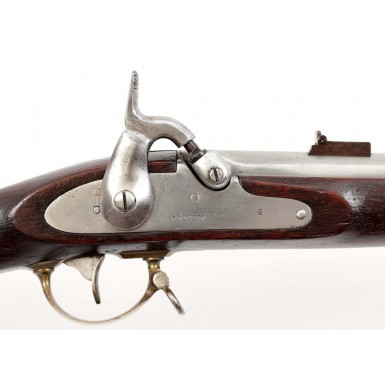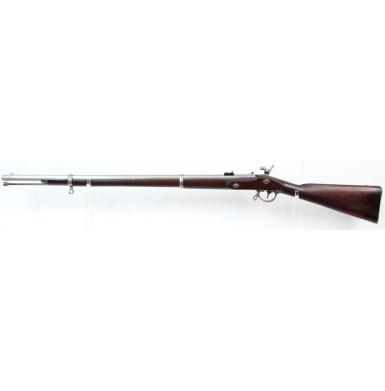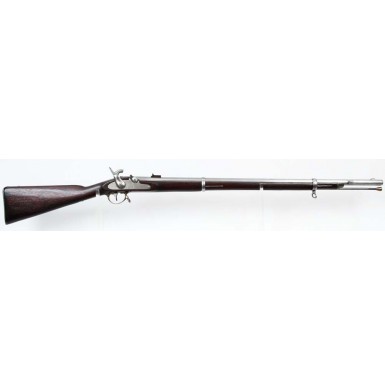The Short Enfield Rifles produced by the Whitney Arms Company represent another unique series of rifles similar to Whitney’s “Good & Serviceable Arms”. The guns were produced in small batches, in a variety of configurations and utilized a combination of obsolete, condemned, surplus and newly made parts. The Whitney Enfield Rifles were produced in at least four variants, with features such as the presence or absence of a patchbox, the type of rear sight and the type of bayonet lug being the primary differences. In general all of the rifles were loosely based upon the British P-1856 rifle and the US M-1855 rifle. Collectors have referred to the guns as “Enfields’ due to Whitney’s use of Pattern 1853 Type II Enfield style barrel bands on all of the guns Unlike the P-1853 Type III Enfield barrel bands (aka Palmer Patent Clamping Bands) found on most Civil War era Enfields, the Type II bands were solid and were retained by band springs set into the stock. It appears that the early Whitney Enfields used left over barrel bands Crimean War era Enfield contract. Whitney had purchased a huge number of finished and unfinished Enfield parts at auction when Robbins & Lawrence went out of business. The Type II upper band was quite wide and early Whitney Enfields have this type of band. Later Whitney Enfields used a narrower upper band that was likely newly made. All of the Whitney Enfield pattern rifles had .58 caliber barrels that were between 32” and 33” in length and flat, flush-fit locks that were similar to Enfield pattern locks. Like the Whitney M-1855 type rifle muskets, the barrel were marked with an alphanumeric “serial number” near the muzzle. The Type I and Type II rifles included an oval patch box in the obverse buttstock, while the Type III and Type IV rifles did not. The Type I did not accept a bayonet, while the Type II and Type III guns had a saber bayonet lug and the Type IV rifle had a front sight/lug for an angular socket bayonet. Type I rifles typically had fixed rear sights, Type II rifles typically had “long range”, long base ladder rear sights Type III rifles had either the “long range” or the Whitey “mid-range” rear sight and most Type IV rifles had “mid-range” rear sight. The typology of the rifles varies from source to source, but I am relying on George Moller’s “American Military Shoulder Arms, Volume III” as the most current and correct source of information. His categorization is slightly different from that found in Flayderman’s or some other author’s texts. All of the Whitney “Short Enfield Rifles’ were produced between 1860 and 1861 and it is estimated that between 775 and 2,000 of all types of Whitney Enfield rifles were produced. Many of the earlier production guns were sold to southern states, prior to the outbreaks of the American Civil War. In 1860, the state of Georgia acquired 250 “Whitney Short Enfield Rifles with Saber Bayonets”. Mississippi also ordered “Whitney Short Enfield Rifles with Saber Bayonets” in late 1860, 140 of which were delivered prior to the outbreak of hostilities. In January of 1861 South Carolina purchased 100 Whitney Short Enfields with oval brass patchboxes. As many as 496 “Whitney’s Short Enfield Rifles with Saber Bayonets” were purchased by the US government in the fall of 1861. These arms were acquired from New York based arms and militaria dealer Schuyler, Hartley & Graham. According to a number of sources, it appears that at least two companies of the 10th Rhode Island Infantry were armed with what Moller classifies as Type III Whitney Enfield Rifles.
This is a VERY FINE condition example of the very scarce Whitney Type III Short Enfield Rifle. It is estimated that no more than 600 of these Type III rifles were produced, and probably less than that. The gun is in very crisp and sharp condition and appears to be 100% complete and correct in every way. The rifle is equipped with the Whitney “mid-range” L-shaped leaf sight and has a saber bayonet lug on the right side of the barrel. The lug is numbered 36, the mating number for the bayonet that had been fit to the rifle. The top of the barrel, near the muzzle is marked with the alphanumeric code E 45. The flush-fit, flat lock plate is marked in a single horizontal line: E. WHITNEY along the lower edge, forward of the hammer. Like most Whitney “Enfields”, the lock is secured by a pair of screws that pass through a pair of Enfield style winged, brass screw escutcheons. The lock operates crisply on all positions and is mechanically excellent. The metal of the gun has been lightly cleaned, and has a medium gun metal gray color, slightly toned down from its original “arsenal bright” polish. The metal is mostly smooth, with some thinly scattered, lightly oxidized pinpricking and peppering present on the barrel and lock. The peppering is slightly heavier in the breech and bolster area and on the lock plate, the result of percussion cap flash. The .58 caliber bore of the 33” rifle barrel is in about VERY GOOD condition and retains strong 7-groove Whitney rifling. The bore is mostly bright, but shows some scattered darker patches and would probably benefit from a good scrubbing. The bore shows light pitting along its entire length, with a few patches of more moderate pitting from about middle to barrel and continuing to the muzzle. The rifle has a US M-1855 rifle type front sight and as previously noted a saber bayonet lug near the muzzle. The original Whitney “mid-range” rear sight is in place on the barrel, but the long aperture leaf has been broken or intentionally cut so that the 300-yard aperture is now the top range of the sight and the upper portion that was graduated to 500 yards is no longer present. This appears to have been this way for a very long time, possibly as far back as the period of use. The sight retains about 50% of its original blued finish. The correct two-piece Whitney Enfield triggerguard is in place, with a brass bow mounted to an iron trigger plate. Both original sling swivels are in place on the rifle and the original Whitney pewter forend cap is present at the end of the stock as well. The original Whitney-style, brass tipped ramrod is present and is full length, retaining good threads on the end. The stock of the rifle rates about FINE and is very crisp and sharp throughout. The stock retains good edges and has very good wood to metal fit. The stock is full-length, and free of any breaks, cracks or repairs. The stock does show a number of bumps, dings and handling marks and mars, but shows no serious damage or abuse. The stock does show a couple of minor wood slivers missing from the edges of the ramrod channel, most noticeably near the forend cap.
Overall this is a very nice example of a very scarce Whitney Type III Short Enfield Rifle. These guns do not come on the market often and usually show heavy wear and use. This rifle is one of those guns that could have easily gone to northern or southern soldiers, and would be equally at home in a collection that centers on the arms of either side. For a collector of US secondary military rifles, this is a must have piece, in much better condition than is usually encountered. For an N-SSA shooter and collector, this gun just might be the short rifle you have been looking for to use in competition. No matter what, it is a gun that I am sure you will be very proud to add to your collection.
ON HOLD







